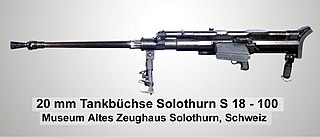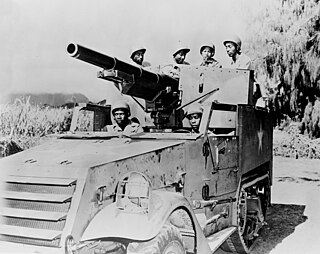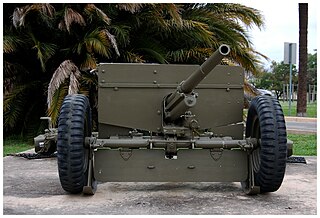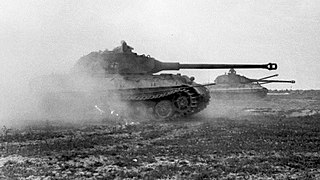
The M4 Sherman, officially Medium Tank, M4, was the most widely used medium tank by the United States and Western Allies in World War II. The M4 Sherman proved to be reliable, relatively cheap to produce, and available in great numbers. Thousands were distributed through the Lend-Lease program to the British Commonwealth and Soviet Union. The tank was named by the British for the American Civil War general William Tecumseh Sherman.

The Panzerkampfwagen IV, commonly known as the Panzer IV, was a German medium tank developed in the late 1930s and used extensively during the Second World War. Its ordnance inventory designation was Sd.Kfz. 161.

The 8.8 cm Flak 18/36/37/41 is a German 88 mm anti-aircraft and anti-tank artillery gun from World War II. It was widely used by Germany throughout the war, and was one of the most recognized German weapons of that conflict. Development of the original model led to a wide variety of guns.

The M18 Hellcat was an American tank destroyer of World War II, also used in the Korean War. It was the fastest U.S. tank on road. The speed was attained by keeping armor to a minimum, using the innovative Torqmatic automatic transmission, and by equipping the relatively light vehicle with the same radial engine used on the much larger Sherman tank.

The Ordnance Quick-Firing 6-pounder 7 cwt, or just 6 pounder, was a British 57 mm gun, serving as a primary anti-tank gun of the British Army during World War II, as well as the main armament for a number of armoured fighting vehicles.

The US 75 mm gun tank gun M2 and the later M3 were the standard American tank guns of World War II, used primarily on the two main American medium tanks of the war, the M3 Lee and the M4 Sherman.

The Pak 36 is a 3.7 cm caliber German anti-tank gun used during the Second World War. It was the main anti-tank weapon of Wehrmacht Panzerjäger units until 1942. Developed by Rheinmetall in 1933, it was first issued to the German Army in 1936, with 9,120 being available by the beginning of the war in September 1939 and a further 5,339 produced during the war. As the predominant anti-tank gun design in the world during the late 1930s, demand was high for the Pak 36, with another 6,000 examples produced for export and the design being copied by the Soviet Union as the 45 mm anti-tank gun M1932 (19-K) and by other nations such as Japan.

The Solothurn S18-1000 20 mm Anti-Tank rifle was a Swiss anti-tank rifle used during the Second World War. It was a variant of the earlier S-18/100 with modifications for a higher muzzle velocity, as well as a larger cartridge size. The more powerful ammunition resulted in significant recoil, which was problematic for the gunner, and its size made portability difficult.

2.8 cm schwere Panzerbüchse 41 or "Panzerbüchse 41" was a German anti-tank weapon working on the squeeze bore principle. Officially classified as a heavy anti-tank rifle, it would be better described, and is widely referred to, as a light anti-tank gun.

The 25 mm Hotchkiss anti-tank gun was a French anti-tank gun that saw service in the first years of the Second World War.

The Pak 97/38 was a German anti-tank gun used by the Wehrmacht in World War II. The gun was a combination of the barrel from the French Canon de 75 modèle 1897 fitted with a Swiss Solothurn muzzle brake and mounted on the carriage of the German 5 cm Pak 38 and could fire captured French and Polish ammunition.

The 3 inch Gun M5 was an anti-tank gun developed in the United States during World War II. The gun combined a 3-inch (76.2 mm) barrel of the anti-aircraft gun T9 and elements of the 105 mm howitzer M2. The M5 was issued exclusively to the US Army tank destroyer battalions starting in 1943. It saw combat in the Italian Campaign and in the Northwest Europe campaign.

The M3 Gun Motor Carriage (GMC) was a United States Army tank destroyer equipped with one 75 mm gun and produced by Autocar. After the fall of France, the U.S. Army decided to make a self-propelled artillery piece from the M1897A4 gun on the M3 chassis, which was designated the T12. After some improvement, it came into production as the M3 Gun Motor Carriage. However, the supply of M2A3 gun shields was insufficient for production needs, so a new gun shield was used. This was designated the M3A1 GMC.

The 240 mm Howitzer M1, popularly nicknamed the "Black Dragon", was a towed howitzer used by the United States Army. The 240 mm M1 was designed to replace the World War I era 240 mm Howitzer M1918 which was based on a 1911 French design and was outdated by World War II. The project to replace the M1918 began in 1941. The 240 mm howitzer was the most powerful weapon deployed by US field artillery units during World War II, able to fire a 360 lb (160 kg) high explosive projectile 25,225 yards (23 km). It was the largest field piece used by the US Army during the war except for naval ordnance adapted into railway guns. The weapon addressed the requirement for super heavy field artillery capable of attacking heavily reinforced targets like those likely to be found along the Siegfried Line.

The 75mm Pack Howitzer M1 was an artillery piece used by the United States. It was designed in the 1920s to meet a need for a howitzer that could be moved across difficult terrain. The gun and carriage was designed so that it could be broken down into several pieces to be carried by pack animals. The gun saw combat in World War II with the United States Army, with US Marine Corps, and was also supplied to foreign forces.

The 37mm Gun M1 was an anti-aircraft autocannon developed in the United States. It was used by the US Army in World War II.

The 4.5 inch Gun M1 was a field gun developed in the United States in the beginning of World War II. It shared the same carriage with the 155mm Howitzer M1 and fired the same ammunition as the British BL 4.5 inch Medium Field Gun. The weapon was used by the US Army in Northwest Europe late in the war for corps support; with the end of hostilities it was declared obsolete.

The T19 Howitzer Motor Carriage (HMC), was a 105 mm (4.1 in) howitzer mounted on a M3 Half-track chassis. It saw service during World War II with the U.S. Army. Its secondary armament consisted of an air-cooled .50 in (13 mm) M2 machine gun for local defense. It was produced by Diamond T between January 1942 and April 1942.



























